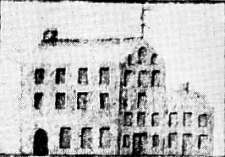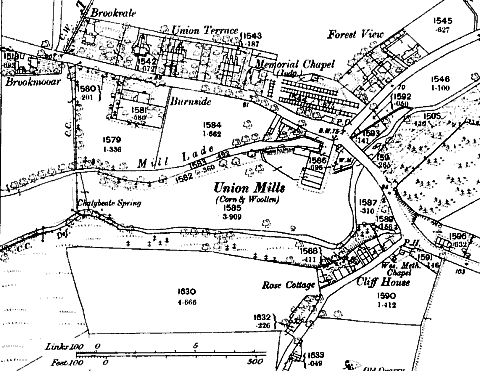[taken from Journal Manx
Museum vol 2 #41]
Union Mills
The prosaic and commonplace title of the village of 'Union Mills' is given
a more romantic character when one learns how it got the name. The reason
is clearly apparent in the facsimile of the piece of card
money issued by William Kelly
in 1811, on the head of which the words Flail and Fleece United are used as
a motto.

There were two mills at the opening of the 19th century under the same management,
one for grinding corn and the other for making cloth : flail and fleece!
This at any rate gives a reason, if not a measure of piquancy, for the use
of a name which has given rise to many queries, and to many commonplace replies.
The mill was in 1511 called Mullin Doway, the 'mill on the Black Ford'; in
the middle of the 17th century it was called 'Mullin Oates, ' Oates' Mill,'
it being then owned by the Oates family. In the beginning of the 19th century
it became known as the Union Mills for the reason given above.
The corn mill was in use at the end of the 15th century. Otes McTagart owned
it in the year 1511, his rent being 9/8. A new mill was built alongside and
the manufacture of cloth was commenced in 1807 by William Kelly, an enterprising
member of the family of Kelly of Trollaby, and one who as an 'extreme reformer'
took a very keen interest in the politics of the day. The cloth mill continued
to prosper for many years. In 1828 it was completely destroyed by fire, and
after its re-erection was fitted up with new machinery and its management
undertaken by Messrs. James Grellier & Co., by whom (according to The
Manx Sun) the manufacture was carried on with great success. William Dalrymple
followed Grellier, and Dalrymple
Maitland and others continued it down to recent times.
In a later paragraph it is stated
Note the caption 'Flail and Fleece,' referring to the owner's two mills,
the old Corn Mill and the new Cloth Mill. This accounts for the present name
of the village - Union Mills. On the obverse is a sketch of the two mills.
After 123 years the exterior has not greatly changed. - written in 1934, the
mills are now demolished.
Additional Information
The village is on the main road from Douglas to Peel, seen running east to
west on the map below, which dates from before the railway of 1873.

Ordnance Survey 1868 - sheet XIII.
3
The drying field for the woolen blankets supported on tenterhooks
is obvious - known as tenter field. The mill lade supplied the water to drive
the mill. The mill passed into the Stevenson family with the marriage of Avril
Oates and John Stevenson, this was before 1665 as in that year he had to mortgage
half the mill etc for £16, a debt that was not paid off until 1701. The
mill remained in the Stevenson family until 1804 when William Kelly bought it.
He built the adjacent woollen mill but a forced coronor's sale saw it pass the
Thomas Harrison in 1827 - presale it was described as
that capital very extensive and valuable concern, situate in the parish of
Kirk Braddan called "The Union Mills" about two and a half miles
from Douglas, consisting of a water corn mill and two kilns; a spinning, carding
and woollen manufactury (the only one of its kind on the island); a dye house
and offices attached a weaving and drying house, a genteel country cottage
with a small garden or court in front, several dwelling houses for work-men
connected with the mills, the whole of the machinery, implements thereto belonging
complete and a variety of goods and effects.
The several dwelling houses included the block of 6 back-to-back
cottages adjacent to the 1860's Wesleyan Chapel seen on the map.
The Mill was very badly damaged by fire in 1828, apparently starting
in the Corn Mill, but being insured it was soon rebuilt and both Corn and Woollen
mills etc were back in operation by early 1829 - the lease was held by James
Grellier, who was also a newspaper proprietor so presumeably he employed others
to manage the business. James Dalrymple and Thomas Maltby were involved in the
operation of the woollen mill, and when in 1835 the corn mill lease was advertised
they formed a partnership with James Kelly to run the two mills. Thomas Maltby
died in 1843 whilst saving the mill from fire when a cask of naptha caught fire.
The Mills again caught fire in 1858, but again the insurance paid
up and the mill was rebuilt. Yet another accident occured in 1875 when William
Dalrymple decided to switch to steam power - a recently built chimney collapsed
on top of the weaving shed killing Robert Green a carder. The mills were sold
to a public company in 1887, but the woollen mill closed in 1891 whilst the
corn mill continued until 1924. After this the buildings were used for several
purposes.
The two interesting characters of around 1830 are James Dalrymple
(1777-1861) and Thomas Maltby (1806-1843) - the former having at one time trained
to be a Congregationalist minister, the latter supposedly concerned with the
wool trade in Leeds before arrival on the Island in the late 1820's. James,
son of David Dalrymple, had briefly emigrated to America whilst young, but returned
to Scotland and became a preacher. It was supposedly on the return from Liverpool
that his ship was forced by bad weather to put in at Douglas where on the Sunday,
there being no minister present, he was asked to give an address which so impressed
the congregation that they asked him to return as minister. The only problem
with this story is what chapel ? and what year ? Some time between 1818 and
1825 when they started to farm Ballastole he is linked with Kirk Michael - there
was a congregational chapel in Douglas from 1813 - that led by Samuel
Haining who was there until his death in 1846 - there was a brief congregational
church established in Peel around 1822 which does not seem to have had a resident
minister, also around 1822 there is mention of the formation of an Itinerant
Congregational ministry, possibly he was linked with these?
Thomas Maltby, son of William and Lydia Maltby,
supposedly came to the Island to seek work, having found it he returned to Leeds
to fetch an extended family of widowed father, a brother and sister together
with two Broadbent cousins. In October 1830 he married Esther Karran, daughter
of William Karran captain of Marown parish. In 1833 his sister married John
Robinson whose first wife had died the previous year. He appears on the
Wesleyan Methodist Plan for 1843
as 'on trial'.
TBA
References
P. M. Lewthwaite Flail and Fleece United The History of Union Mills
Privately Published 1986
T.A.Bawden, L.S. Garrad, et al The Industrial Archaeology of the Isle
of Man Newton Abbot: David & Charles 1972 (ISBN 0-7153-5440-X)
P.M. Lewthwaite Union Mills in the 19th Century IoM Fam
Hist Soc vol 7 #2 pp49-53
|
|

|
|
|
|
|
Any comments, errors or omissions gratefully received
MNB Editor
©
F.Coakley , 2003
|


